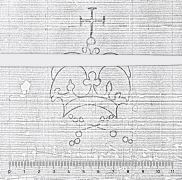Paper and Copyists in Viennese Opera Scores, 1760–1775
Martin Eybl
Thursday, March 7, 2024

The following guest post is by Martin Eybl (Institut für Musikwissenschaft und Interpretationsforschung, Universität für Musik und darstellende Kunst Wien, Austria):
Hundreds of works by Haydn, Gluck, and other Viennese composers are only known from manuscript copies prepared by their contemporaries. As a rule, such manuscripts are undated, which makes it difficult to assess their source value and draw conclusions as to when the works themselves may have been composed. Given that professional copyists changed their paper quite frequently, an overview of datable papers allows us to date other manuscripts also written in Vienna. With that in mind, as part of the project “Paper and Copyists in Viennese Opera Scores, 1760–1775” lead by Martin Eybl since 2014, around 150 datable opera scores from Habsburg collections have been examined in order to identify the professional copyists (if possible also by name) and the types of paper used. While the comparison of individual aspects can be useful, it is their combination that provides the most important key to establishing the date of copying.
We use a precise, simple and inexpensive method for recording watermarks by combining transmitted light photography and image subtraction. The digital processing allows for a systematic search for copyists, watermarks/papers, as well as the physical composition of manuscripts. On the project website, where we have been linking each manuscript with the corresponding RISM entry since fall 2023, researchers – whether arriving from musicology or more invested in paper studies – can freely access the data. A “Copyist Identifier,” in which one can select a set of scribal features (such as clefs, note shapes, rests, time signatures, etc.), supports the online identification of copyist’s hands also in other Viennese manuscripts from the 1760s and 70s and their association with datable opera scores.
From 1760 to 1775 many (especially Italian) operas were performed in Vienna, and their scores were collected by the court, which makes the above period ideal for this type of study. Due to the dense sequence of sources, the catalogs of papers and copyists’ hands we have compiled likely cover decisive parts of the overall production of music manuscripts in Vienna, and allow one to determine how long a paper remained in use and how long a copyist was active on the market. So far, we have been able to identify around 80 copyists and over 70 papers (including their variants resulting from wear and tear of the moulds). The majority of the papers originate from the Toscolano Valley on the eastern shore of Lake Garda, where in the 18th century paper of the highest quality was produced and then distributed throughout Europe via Venice. Most of the copyists belonged to two workshops. One of them was run by the independent entrepreneur Therese Ziss, the widow of the last court copyist who died in 1755.
For more information about the project, see here.
For individual manuscripts, see for example here.
Image: Watermark of the paper mill Antonio Seguito, Toscolano, P&C Watermark P71A, Countermark
Share Tweet EmailCategory: New at RISM

